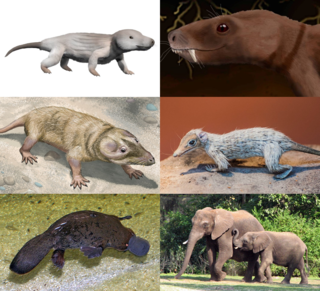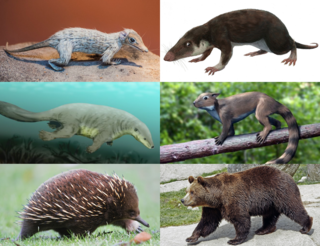
Ungulates are members of the diverse clade Euungulata, which primarily consists of large mammals with hooves. Once part of the clade "Ungulata" along with the clade Paenungulata, "Ungulata" has since been determined to be a polyphyletic and thereby invalid clade based on molecular data. As a result, true ungulates had since been reclassified to the newer clade Euungulata in 2001 within the clade Laurasiatheria while Paenungulata has been reclassified to a distant clade Afrotheria. Living ungulates are divided into two orders: Perissodactyla including equines, rhinoceroses, and tapirs; and Artiodactyla including cattle, antelope, pigs, giraffes, camels, sheep, deer, and hippopotamuses, among others. Cetaceans such as whales, dolphins, and porpoises are also classified as artiodactyls, although they do not have hooves. Most terrestrial ungulates use the hoofed tips of their toes to support their body weight while standing or moving. Two other orders of ungulates, Notoungulata and Litopterna, both native to South America, became extinct at the end of the Pleistocene, around 12,000 years ago.

Synapsida is one of the two major clades of vertebrate animals in the group Amniota, the other being the Sauropsida. The synapsids were the dominant land animals in the late Paleozoic and early Mesozoic, but the only group that survived into the Cenozoic are mammals. Unlike other amniotes, synapsids have a single temporal fenestra, an opening low in the skull roof behind each eye orbit, leaving a bony arch beneath each; this accounts for their name. The distinctive temporal fenestra developed about 318 million years ago during the Late Carboniferous period, when synapsids and sauropsids diverged, but was subsequently merged with the orbit in early mammals.

Therapsida is a clade composing of a major group of eupelycosaurian synapsids that includes mammals and their ancestors and close relatives. Many of the traits today seen as unique to mammals had their origin within early therapsids, including limbs that were oriented more underneath the body, resulting in a more "standing" quadripedal posture, as opposed to the lower sprawling posture of many reptiles and amphibians.

Eutheria, also called Pan-Placentalia, is the clade consisting of placental mammals and all therian mammals that are more closely related to placentals than to marsupials.

Cynodontia is a clade of eutheriodont therapsids that first appeared in the Late Permian, and extensively diversified after the Permian–Triassic extinction event. Mammals are cynodonts, as are their extinct ancestors and close relatives (Mammaliaformes), having evolved from advanced probainognathian cynodonts during the Late Triassic.

Eucynodontia is a clade of cynodont therapsids including mammals and most non-mammalian cynodonts. The oldest eucynodonts are known from the Early Triassic and possibly Late Permian. Eucynodontia includes two major subgroups, Cynognathia and Probainognathia.

Euarchontoglires, synonymous with Supraprimates, is a clade and a superorder of mammals, the living members of which belong to one of the five following groups: rodents, lagomorphs, treeshrews, primates, and colugos.

Hadrocodium wui is an extinct mammaliaform that lived during the Sinemurian stage of the Early Jurassic approximately 195 million years ago in the Lufeng Formation in what is now the Yunnan province in south-western China (25.2°N 102.1°E, paleocoordinates 34.3°N 104.9°E). It is considered as the closest relative of the class Mammalia.

Mammaliaformes is a clade that contains the crown group mammals and their closest extinct relatives; the group radiated from earlier probainognathian cynodonts. It is defined as the clade originating from the most recent common ancestor of Morganucodonta and the crown group mammals; the latter is the clade originating with the most recent common ancestor of extant Monotremata, Marsupialia, and Placentalia. Besides Morganucodonta and the crown group mammals, Mammaliaformes includes Docodonta and Hadrocodium.

Boreoeutheria is a magnorder of placental mammals that groups together superorders Euarchontoglires and Laurasiatheria. With a few exceptions, male boreoeutherians have a scrotum, an ancestral feature of the clade. The sub-clade Scrotifera was named after this feature.

Ferungulata is a grandorder of placental mammals that groups together mirorder Ferae and clade Pan-Euungulata. It has existed in two guises, a traditional one based on morphological analysis and a revised one taking into account more recent molecular analyses. The Fereungulata is a sister group to the order Chiroptera (bats) and together they make clade Scrotifera.
Kuehneotheriidae is an extinct family of mammaliaforms traditionally placed within 'Symmetrodonta', though now generally considered more basal than true symmetrodonts. All members of Kuehneotheriidae which have been found so far are represented only by teeth, but these teeth have features which have led paleontologists to classify kuehneotheriids as very close relatives of the first true mammals. But fossil clades based solely on teeth often lead to difficulties, and it is not possible to draw significant conclusions about mammalian evolution from Kuehneotheriidae unless some more complete skeletons are found.

The evolution of mammalian auditory ossicles was an evolutionary process that resulted in the formation of the bones of the mammalian middle ear. These bones, or ossicles, are a defining characteristic of all mammals. The event is well-documented and important as a demonstration of transitional forms and exaptation, the re-purposing of existing structures during evolution.

Dryolestida is an extinct order of mammals, known from the Jurassic and Cretaceous. They are considered basal members of the clade Cladotheria, close to the ancestry of therian mammals. It is also believed that they developed a fully mammalian jaw and also had the three middle ear bones. Most members of the group, as with most Mesozoic mammals, are only known from fragmentary tooth and jaw remains.

Dryolestidae is an extinct family of Mesozoic mammals, known from the Middle Jurassic to the Early Cretaceous of the North Hemisphere. The oldest known member, Anthracolestes, is known from the Middle Jurassic Itat Formation of Western Siberia, but most other representatives are known from the Late Jurassic of North America and the Late Jurassic and Early Cretaceous of Europe. Most members are only known from isolated teeth and jaw fragments. Like many other groups of early mammals, they are thought to have been insectivores. They are generally classified in Cladotheria, meaning that they are considered to be more closely related to marsupials and placentals than to monotremes. They are placed as part of the broader Dryolestida, which also includes the Paurodontidae, and also sometimes the South American-Antarctic Meridiolestida, which are often considered unrelated cladotherians. Dryolestidae taxon is not based on a phylogenetic definition, but instead on the possession of unequal roots for the molars of the lower jaw. Additionally, the clade is distinguished by hypsodonty in lower molars, and uneven labio-lingual height for the alveolar borders of the dentary.

Monotremes are mammals of the order Monotremata. They are the only known group of living mammals that lay eggs, rather than bearing live young. The extant monotreme species are the platypus and the four species of echidnas. Monotremes are typified by structural differences in their brains, jaws, digestive tract, reproductive tract, and other body parts, compared to the more common mammalian types. Although they are different from almost all mammals in that they lay eggs, like all mammals, the female monotremes nurse their young with milk.

Pachygenelus is an extinct genus of tritheledontid cynodonts. Fossils have been found from the Karoo basin in South Africa and date back to the Early Jurassic.

Apatemyidae is an extinct family of placental mammals that took part in the first placental evolutionary radiation together with other early mammals such as the leptictids. Their relationships to other mammal groups are controversial; a 2010 study found them to be basal members of Euarchontoglires.

Haramiyavia is a genus of synapsid in the clade Haramiyida that existed about 200 million years ago in the Rhaetian stage of the Triassic. Like other haramiyidans, it was likely a non-mammalian mammaliaform. It contains a single species, H. clemmenseni from the Fleming Fjord Formation of Greenland, and has been assigned to the monogeneric family Haramiyaviidae.

Pholidotamorpha is a clade of placental mammals from mirorder Ferae that includes the order Pholidota and extinct order Palaeanodonta.
























